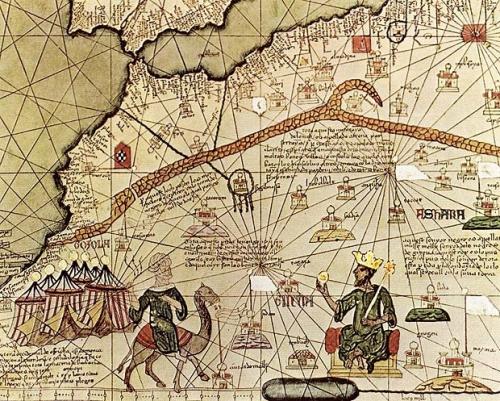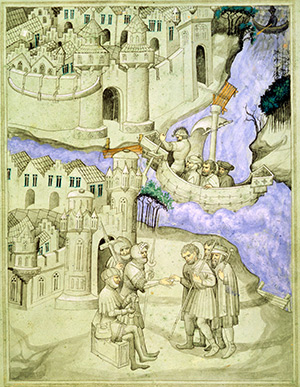Week 4. Religious Travel in the Global Middle Ages
Pilgrimage, proselytising, and religious study have been major factors for human mobility throughout history, and were both cause and consequence of the intense trans-regional connectivity characterising the "Global Middle Ages". Involving people of different genders and social backgrounds, religious travel is a feature common to each of the world's major religious traditions. In this seminar we will compare the experiences and writings of Jewish, Muslim, Christian, and Buddhist travellers as a means to examine different types of historical records of travel, the types of information they provide, and the various approaches that can be used to study them.
Core Readings (pick two)
Martin Jacobs, '"A Day's Journey": Spatial Perceptions and Geographic Imagination in Benjamin of Tudela's Book of Travels', The Jewish Quarterly Review 109.2 (2019), pp. 203-232. Link.
Michael Gomez, African Dominion: A New History of Empire in Early and Medieval West Africa (Princeton, NJ: Princeton University Press, 2018), pp. 104-125. Link.
Saeko Kimura, 'Regeneration Narratives: The Confessions of Lady Nijō as a Story for Women's Salvation', Review of Japanese Culture and Society 19 (2007), pp. 87-102. Link.
Primary Sources (pick two)
Whalen, Brett Edward (ed.), Pilgrimage in the Middle Ages: A Reader (Toronto: University of Toronto Press, 2011), pp. 23-26 (Etheria); pp. 280-284 (Benjamin of Tudela); pp. 285-295 (Rabban Sauma); pp. 304-308 (Mansa Musa). Link
Tabish Khair, Martin Leer, Justin D. Edwards, and Hanna Ziadeh (eds.), Other Routes: 1500 Years of African and Asian Travel Writing (Bloomington, IN: Indiana University Press, 2005), pp. 71-75 ('The Pilgrimages of Lady Nijô (b. 1271)'). Link.
Seminar preparation
1. The three secondary readings each represent a different approach to studying travel. Synthesize the approach of the articles you've read in a sentence or two. What accounts for their differences? Which holds the greatest appeal for you and why?
2. Different primary sources lend themselves to different kind of questions. What kind of information and insights can be obtained from the sources you picked? Why is this relevant?
Seminar Questions
- How does Jacobs situate his approach to Benjamin of Tudela’s account historiographically? How might you use his article for a historiographical essay?
- What is the nature of “real and imagined geography” (p. 223) in Benjamin of Tudela’s account? How useful do you find the distinction for analysing travel narratives?
- Was Mansā Mūsā’s hajj primarily religious or political in nature? Why?
- In what ways does Mansā Mūsā’s hajj shed light on wider social, political, and economic conditions? Which do you find most suggestive in thinking about travel history, and why?
- “A man is more of less free to travel eastward or even to China, but there are so many hindrances for a traveling woman that I understand it to be impossible.” (Emperor Go-Fukakusa to Lady Nijō, c. 1300). How does (religious) travel intersect with gender?
- How do Lady Nijō’s Confessions offer an alternative view on (religious) travel?
Further Reading
Adler, Elkan Nathan (ed.), Jewish Travellers (New York: Routledge, 1930). Link.
Buswell, Robert E. 'Korean Buddhist Journeys to Lands Worldly and Otherworldly' The Journal of Asian Studies 68.4 (2009), pp. 1055-1075. Link.
Campbell, Mary Baine, 'Medieval Travel Writing (1): Peregrinatio and Religious Travel Writing', in: Nandini Das and Tim Youngs (eds.), The Cambridge History of Travel Writing (Cambridge: Cambridge University Press, 2019), 33-47. Link.
Chareyron, Nicole, Donald Wilson (trans.), Pilgrims to Jerusalem in the Middle Ages (New York: Columbia University Press, 2005). Link.
Coleman, Simon, and John Elsner, Pilgrimage: Past and Present in the World Religions (Cambridge, MA: Harvard University Press, 1997). Library.
Craig, Leigh Ann, Wandering Women and Holy Matrons: Women as Pilgrims in the Later Middle Ages (Leiden and Boston: Brill, 2009). Link.
Eastmond, Antony, Tamta's World: The Life and Encounters of a Medieval Noblewoman from the Middle East to Mongolia (Cambridge: Cambridge University Press, 2017). Link.
Eickelman, Dale F., and James P. Piscatori (eds.), Muslim Travellers: Pilgrimage, Migration, and the Religious Imagination (London: Routledge, 1990). Link.
Gordon, Stewart, When Asia was the World: Traveling Merchants, Scholars, Warriors and Monks Who Created the "Riches of the East" (Philadelphia: Da Capo Press, 2008). Link.
Gosch, Stephen S., and Peter N. Stearns, Premodern Travel in World History (New York: Routledge, 2008), Ch. 5 'Buddhist Journeys, 400-900 CE' and Ch. 7 'Muslim Travelers, 700-1400 CE'. Link.
Hargett, James, Stairway to Heaven: A Journey to the Summit of Mount Emei (Albany: State University of New York Press, 2006). [Primary source] Link.
Hargett, James, 'What Need is There to Go Home? Travel as a Leisure Activity in the Travel Records (Youji 游記) of Su Shi 蘇軾 (1037–1101)', The Chinese Historical Review 23.2 (2016), pp. 111-129. Link.
Hayden, Judy A., and Nabil Matar (eds.), Through the Eyes of the Beholder: The Holy Land, 1517-1713 (Leiden and Boston: 2013). Link.
Hermans, Erik, A Companion to the Global Middle Ages (Leeds: Arc Humanities Press, 2020). Link.
Jacobs, Martin, Reorienting the East: Jewish Travelers to the Medieval Muslim World (Philadelphia: University of Pennsylvania Press, 2014). Link.
Khanmohamadi, Shirin A., In Light of Another's Word : European Ethnography in the Middle Ages (Philadelphia, PA: The University of Pennsylvania Press, 2014), pp. 57-87. Link.
Le Beau, Bryan F., and Menachem Mor (eds.), Pilgrims & Travelers to the Holy Land (Omaha: Creighton University Press, 1996).
Legassie, Shane Aaron, The Medieval Invention of Travel (Chicago: University of Chicago Press, 2017).
Morère, Nuria, 'Antiquity in Benjamin of Tudela’s Travel Narrative: Interpretation and Meaning within the Context of the History of Travel', Journal of Tourism History 9.1 (2017), pp. 27-43. Link.
Netton, Ian Richard (ed.), Islamic and Middle Eastern Geographers and Travellers (4 vols. London: Routledge, 2008).
Ohler, Norman, Caroline Hiller (trans.), The Medieval Traveller (Woodbridge: Boydell, 1989).
Peters, F.E., The Hajj: the Muslim Pilgrimage to Mecca and the Holy Places (Princeton, NJ: Princeton University Press, 1994), Ch. 3: 'The Medieval Hajj (1100-1400 C.E.)'. Link.
Phillips, Kim M., Before Orientalism: Asian Peoples and Cultures in European Travel Writing, 1245-1510 (Philadelphia, PA: The University of Pennsylvania Press, 2013). Link.
Romano, John (ed.), Medieval Travel and Travelers: A Reader (Toronto: University of Toronto Press, 2020). [Primary source excerpts] Link.
Rossabi, Morris, Voyager from Xanadu: Rabban Sauma and the first journey from China to the West (Berkeley, CA: University of California Press, 2010) Link.
Shalev, Zur, 'Benjamin of Tudela, Spanish Explorer', Mediterranean Historical Review 25.1 (2010), pp. 17-33. Link.
Touati, Houari, trans. Lydia G. Cochrane, Islam and Travel in the Middle Ages (Chicago: University of Chicago Press, 2010).
Wriggins, Sally Hovey, The Silk Road Journey with Xuanzang (Boulder, CO: Westview Press, 2004). Link.


.
